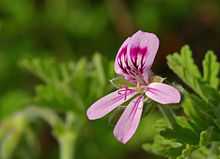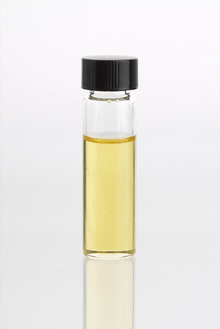Pelargonium graveolens
| Pelargonium graveolens | |
|---|---|
 | |
| Scientific classification | |
| Kingdom: | Plantae |
| (unranked): | Angiosperms |
| (unranked): | Eudicots |
| (unranked): | Rosids |
| Order: | Geraniales |
| Family: | Geraniaceae |
| Genus: | Pelargonium |
| Species: | P. graveolens |
| Binomial name | |
| Pelargonium graveolens L'Hér.[1] | |
The true Pelargonium graveolens is an uncommon species in the Pelargonium genus, which is native to South Africa, Zimbabwe and Mozambique, while the plants cultivated under this name (spelled P. 'Graveolens') differ from the wild specimens and are of hybrid origin [1] (a probable cross between Pelargonium graveolens, P. capitatum and / or P. radens, or other closely related species). Often called a geranium, as it falls within the plant family Geraniaceae, and was previously categorised under the same genus. The common P. 'Graveolens' or P. 'Rosat' has great importance in the perfume industry. It is cultivated on a large scale and its foliage is distilled for its scent. P. 'Graveolens' cultivars have a wide variety of smells, including rose, citrus, mint, coconut and nutmeg, as well as various fruits. However, the most commercially important varieties are those with rose scents.
Nomenclature and taxonomy
Synonym
Common names include rose geranium,[1][2][3] old fashion rose geranium,[2] and rose-scent geranium.[1] Pelargonium graveolens is also known by taxonomic synonyms "Geranium terebinthinaceum Cav." and Pelargonium terebinthinaceum (Cav.) Desf."[1] "Rose geranium" is sometimes used to refer to "Pelargonium incrassatum (Andrews) Sims" or its synonym "Pelargonium roseum - the herbal name- (Andrews) DC."[4] Commercial vendors often list the source of geranium or rose geranium essential oil as Pelargonium graveolens regardless of its botanical name.
Uses
Pelargonium distillates and absolutes, commonly known as "geranium oil", are sold for aromatherapy and massage therapy applications. They are also sometimes used to supplement or adulterate more expensive rose oils. The essential oil is an ingredient in a "natural" haemorrhoid treatment.[5]
As a flavoring, the flowers and leaves are used in cakes, jams, jellies, ice creams, sorbets, salads, sugars,[6] and teas.
Variety
A variety that matches this name is Lady Plymouth geranium.
Chemical consituents of geranium oil

A modern analysis listed the presence of over 50 organic compounds in the essential oil of P. graveolens from an Australian source.[7] Analyses of Indian geranium oils indicated a similar phytochemical profile, and showed that the major constituents (in terms of % composition) were citronellol + nerol and geraniol.[8][9]
Gallery
-

The cluster of cultivated P. 'Graveolens'
-

A bee on a cluster of cultivated P. 'Graveolens'
See also
References
- ↑ 1.0 1.1 1.2 1.3 1.4 USDA ARS NPGS. "Pelargonium graveolens information from NPGS/GRIN". United States Department of Agriculture (USDA), Agricultural Research Service (ARS), National Plant Germplasm System (NPGS). Accessed June 23, 2007.
- ↑ 2.0 2.1 "Pelargonium graveolens". Plants For A Future. Accessed June 23, 2007.
- ↑ USDA NCRS. "PLANTS Profile for Pelargonium graveolens (sweet scented geranium)". United States Department of Agriculture (USDA), Natural Resources Conservation Service (NCRS), PLANTS Database. Accessed June 23, 2007.
- ↑ "Pelargonium incrassatum". Plants For A Future. Accessed June 23, 2007.
- ↑ http://www.amoils.com/h-hemorrhoids-ingredients.html, http://www.amoils.com/hemorrhoids.html
- ↑ Encyclopedia of Spices
- ↑ R. A. Shellie and P. J. Marriott (2003). "Comprehensive two-dimensional gas chromatography-mass spectrometry analysis of Pelargonium graveolens essential oil using rapid scanning quadrupole mass spectrometry." Analyst 128 879-883.
- ↑ N. Jain, K. K. Aggarwal, K. V. Syamasundar, S. K. Srivastava and S. Kumar (2001). "Essential oil composition of geranium (Pelargonium sp.) from the plains of Northern India." Flavour and Fragrance J. 16 44–46.
- ↑ R. Gupta, G. R. Mallavarapu, S. Banerjee and S. Kumar (2001). "Characteristics of an isomenthone-rich somaclonal mutant isolated in a geraniol-rich rose-scented geranium accession of Pelargonium graveolens." Flavour and Fragrance J. 16 319–324.
| Wikimedia Commons has media related to Pelargonium graveolens. |